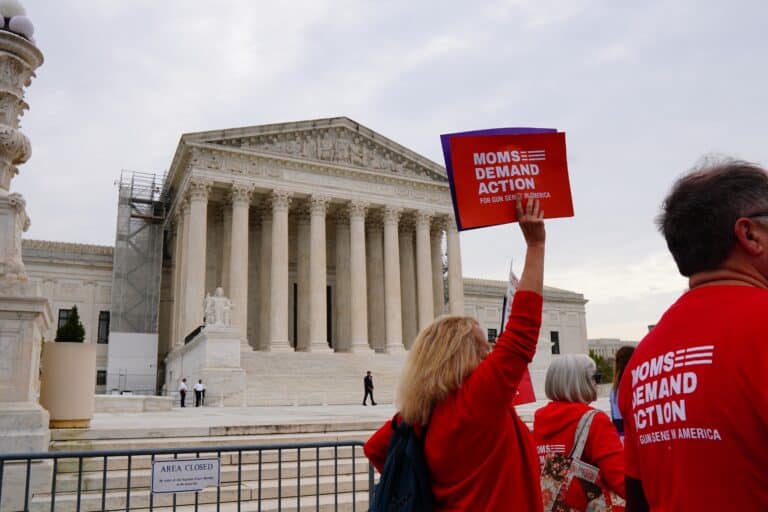The Supreme Court of the United States (SCOTUS) ruled today that people determined by a court to be dangerous can be disarmed–at least temporarily.
The majority determined the federal law that bars those subject to domestic violence restraining orders from possessing guns is not unconstitutional on its face. It also found the law was constitutional as applied to defendant Zachary Rahimi, who was specifically found by a judge to be a threat to the mother of his child.
“When a restraining order contains a finding that an individual poses a credible threat to the physical safety of an intimate partner, that individual may—consistent with the Second Amendment—be banned from possessing firearms while the order is in effect,” Chief Justice John Roberts wrote in US v. Rahimi. “Since the founding, our Nation’s firearm laws have included provisions preventing individuals who threaten physical harm to others from misusing firearms. As applied to the facts of this case, Section 922(g)(8) fits comfortably within this tradition.”
Only Justice Clarence Thomas, who wrote the landmark 2022 ruling in New York State Rifle and Pistol Association v. Bruen, dissented.
The ruling is the first to shed new light on how the Supreme Court expects lower courts to carry out the Second Amendment test it handed down in 2022’s New York State Rifle and Pistol Association v. Bruen. The Bruen decision emphasized an approach to examining the constitutionality of modern gun laws by determining whether they fit within the history and tradition of gun regulation dating back to the period when the Second Amendment was ratified. Rahimi is the first time The Court has applied that new test itself, and it will have a major impact on how lower courts interpret Second Amendment protections moving forward.
The case centered around Rahimi, who was convicted of violating his restraining order by possessing firearms after police found them in his room during a search related to other crimes he was accused of committing. He appealed his conviction on the grounds it violated his Second Amendment rights. A Fifth Circuit panel sided with him, finding there was no historical analogue for the domestic violence restraining order Rahimi was disarmed under–a key test under the Bruen decision.
“The Government fails to demonstrate that § 922(g)(8) ‘s restriction of the Second Amendment right fits within our Nation’s historical tradition of firearm regulation. The Government’s proffered analogues falter under one or both of the metrics the Supreme Court articulated in Bruen as the baseline for measuring ‘relevantly similar’ analogues: ‘how and why the regulations burden a law-abiding citizen’s right to armed self-defense,'” Judge Cory T. Wilson wrote for the panel. “As a result, § 922(g)(8) falls outside the class of firearm regulations countenanced by the Second Amendment.”
SCOTUS disagreed, saying Rahimi can be lawfully disarmed under the Second Amendment. It rebuked some lower courts that it said had become too strict in trying to find
“[S]ome courts have misunderstood the methodology of our recent Second Amendment cases. These precedents were not meant to suggest a law trapped in amber,” Roberts wrote. “As we explained in Heller, for example, the reach of the Second Amendment is not limited only to those arms that were in existence at the founding. Rather, it ‘extends, prima facie, to all instruments that constitute bearable arms, even those that were not [yet] in existence.’ By that same logic, the Second Amendment permits more than just those regulations identical to ones that could be found in 1791. Holding otherwise would be as mistaken as applying the protections of the right only to muskets and sabers.”
The Court insisted it never intended for the Bruen test to require historical analogues to be twins. It only required that they establish a tradition in line with the modern regulation.
“[W]e have no trouble concluding that Section 922(g)(8) survives Rahimi’s facial challenge,” Roberts wrote. “Our tradition of firearm regulation allows the Government to disarm individuals who present a credible threat to the physical safety of others. Section 922(g)(8) can be applied lawfully to Rahimi.”
The majority pointed to two laws in particular as representative of the tradition that the restraining order gun ban fits into. One was a group of laws that required those who were accused of being a danger to post a type of bond against breaching the peace. The other group of statutes bared people who were accused of being dangerous from carrying arms in an effort to terrify the public.
“Taken together, the surety and going armed laws confirm what common sense suggests: When an individual poses a clear threat of physical violence to another, the threatening individual may be disarmed,” Roberts wrote. “Section 922(g)(8) is by no means identical to these founding era regimes, but it does not need to be. ”
Justice Thomas disputed that finding. He argued those laws weren’t close enough to the modern prohibition to pass muster.
“The Court has two rejoinders, surety and affray laws,” he wrote. “Neither is a compelling historical analogue. As I have explained, surety laws did not impose a burden comparable to §922(g)(8). And, affray laws had a dissimilar burden and justification. The Court does not reckon with these vital differences, asserting that the disagreement is whether surety and affray laws must be an exact copy of §922(g)(8). But, the historical evidence shows that those laws are worlds—not degrees—apart from §922(g)(8).”
Several of the justices who joined the majority issued concurrences. One common theme in those opinions was the idea The Court has a long way to go in establishing its Second Amendment jurisprudence.
“Our resolution of Mr. Rahimi’s facial challenge to §922(g)(8) necessarily leaves open the question whether the statute might be unconstitutional as applied in ‘particular circumstances,'” Justice Niel Gorsuch wrote. “So, for example, we do not decide today whether the government may disarm a person without a judicial finding that he poses a ‘credible threat’ to another’s physical safety. We do not resolve whether the government may disarm an individual permanently. We do not determine whether §922(g)(8) may be constitutionally enforced against a person who uses a firearm in self-defense. Notably, the surety laws that inform today’s decision allowed even an individual found to pose a threat to another to ‘obtain an exception if he needed his arms for self-defense.’ Nor do we purport to approve in advance other laws denying firearms on a categorical basis to any group of persons a legislature happens to deem, as the government puts it, ‘not ‘responsible.'”
“Who is protected by the Second Amendment, from a historical perspective?” Justice Ketanji Brown Jackson asks. “To what conduct does the Second Amendment’s plain text apply? To what historical era (or eras) should courts look to divine a historical tradition of gun regulation? How many analogues add up to a tradition? Must there be evidence that those analogues were enforced or subject to judicial scrutiny? How much support can nonstatutory sources lend?”
The majority itself cautioned that its ruling is intended to be narrow and does not purport to settle questions beyond the one directly at hand.
“In Heller, McDonald, and Bruen, this Court did not ‘undertake an exhaustive historical analysis . . . of the full scope of the Second Amendment,'” Roberts wrote. “Nor do we do so today. Rather, we conclude only this: An individual found by a court to pose a credible threat to the physical safety of another may be temporarily disarmed consistent with the Second Amendment.”
But it did go on to reject the government’s attempt to establish a new standard for who can be barred from owning guns based on whether they are “responsible.”
“Finally, in holding that Section 922(g)(8) is constitutional as applied to Rahimi, we reject the Government’s contention that Rahimi may be disarmed simply because he is not ‘responsible.’ ‘Responsible’ is a vague term. It is unclear what such a rule would entail,” Roberts wrote. “Nor does such a line derive from our case law. In Heller and Bruen, we used the term ‘responsible’ to describe the class of ordinary citizens who undoubtedly enjoy the Second Amendment right. But those decisions did not define the term and said nothing about the status of citizens who were not ‘responsible.’ The question was simply not presented.”
UPDATE 6-21-2024 6:51 PM EASTERN: This piece has been updated with more quotes from the Supreme Court’s opinion.






